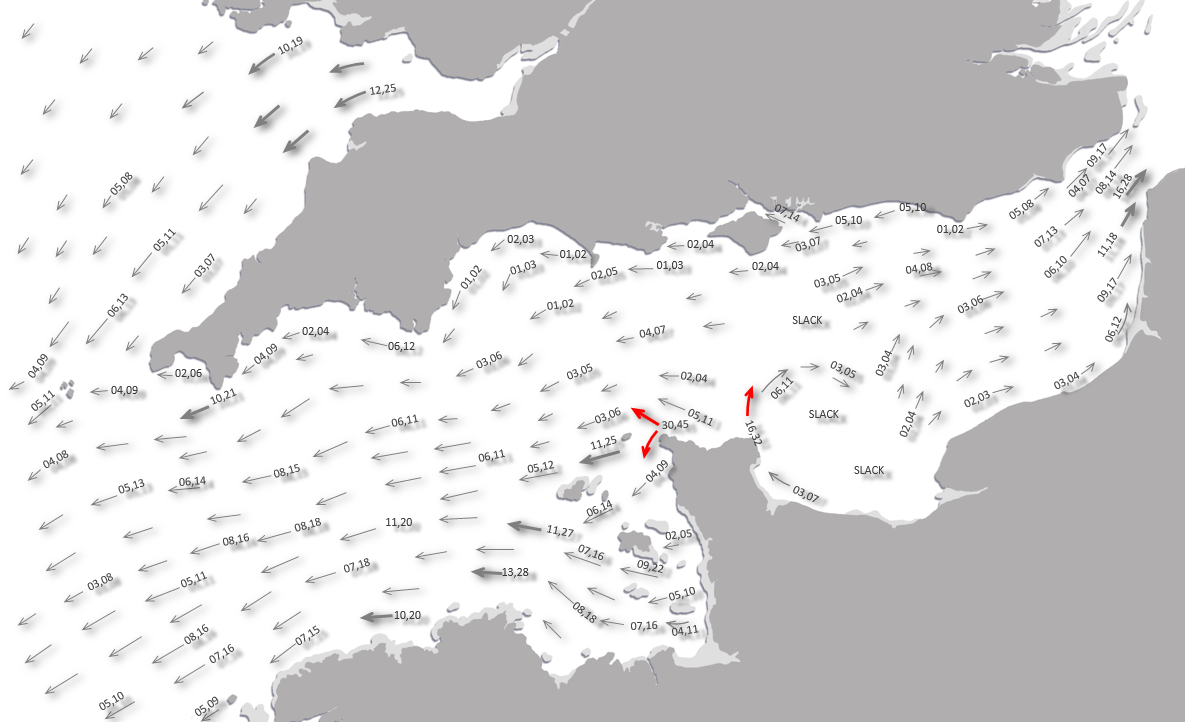- +Local Tides and Tidal Streams
- +Route Weather
- +Find Routes
- +Find Havens
- +Navigational Resources

Small tidal stream inaccuracies can develop when advancing beyond HW Dover +6. Because of this we only enable today's tidal stream chartlets to advance 24 hours. Sorry, future tides are not currently available for this harbour. Please check Admiralty EasyTide.
The above image represents the current tidal streams offshore of this haven. Streams attaining three knots and above are highlighted by red arrows
 . All times are in local time with red text indicating springs, blue indicating neaps and gray between tidal events. Click [+] to advance the estimate by an hour and click [-] to step back.
. All times are in local time with red text indicating springs, blue indicating neaps and gray between tidal events. Click [+] to advance the estimate by an hour and click [-] to step back.
Do you need more information on the tidal graphics?
Arrows represent the direction of tidal streams with lighter or shorter arrows indicating weaker streams. Stronger streams are indicated by heavier or longer arrows, and as mentioned above, red arrows flagging rates of 3 knots and above. Numerals represent [mean neap, mean spring] rates in tenths of a knot. For example the numbers 12,23 would indicate a mean neap of 1.2 knots and a mean spring of 2.3 knots.
More local tidal details
Today's tides — High water: , Low water:Today's Dover tides — High waters: 05:05, 17:57, Low water: 12:11
We are now on Neaps. View future tidal events in our lunar calendar


Spring and neap tides are caused by the gravitational attraction of the moon and to a lesser extent the sun. The complex mix of gravitational forces raise bulges of water on both sides of the Earth. These vary in size depending upon the moon's position as it revolves around the Earth each month.
When the moon's orbit places both the moon and the sun's gravitational forces in line, during New Moon  and Full Moon
and Full Moon  , the water level rises higher, falls lower and the tidal runs are faster than usual. These are called spring tides, shown in red. When the moon is in the First Quarter
, the water level rises higher, falls lower and the tidal runs are faster than usual. These are called spring tides, shown in red. When the moon is in the First Quarter  or Last Quarter
or Last Quarter  , out of phase with the sun, lower tides result and lesser tidal runs will be experienced. These are called neap tides, shown in blue.
, out of phase with the sun, lower tides result and lesser tidal runs will be experienced. These are called neap tides, shown in blue.
The maximum spring tide typically lags a day behind the date of New and Full Moon in the British Isles. This is caused by the water masses inertia and friction plus the physics of 'cause and effect' where the largest impact occurs after the force has been imparted.

This tool can be used to estimate future costal tidal streams for this area. All that is required are two simple steps:
Step 1: What is the Dover High Water for the target date?
Use a current Dover Tide Table to find Dover High Water for the target date. The National Oceanography Centre offers online tidal predictions for up to 28 days from today. Click here to open their tide table for Dover

Step 2: Input the target date's Dover High Water
Taking a mean tidal offset from Dover's tide, we expect your targetted date's associated local tide at to be:
High waters: Low waters:
Data based on an average tide is only accurate to within one hour, if you more precise times are required use the ISA tidal predictions, with offset -01:00.
| Today's overview |
||||
 |
 |
 |
 |
 |
| °C °C |
°C °C |
°C °C |
°C °C |
°C °C |
Headline: Cloudy with patchy rain, but some brighter breaks as well.
Today: A mainly cloudy day with hill fog lingering across the Moors and scattered light rain in places, but some brighter breaks developing further east as well. Milder than Saturday, especially in any sunshine, with light winds for many. Maximum Temperature 15C.
Tonight: Rather cloudy with hill fog lingering across the Moors and the odd spot of rain in places overnight. Mild beneath the cloud, but feeling chilly in any clearer spells. Minimum Temperature 9C.
Monday: Early cloud and light rain soon clear south leaving a dry day with plenty of hazy sunshine. Light winds, and feeling warm in sheltered, sunny spots. Maximum Temperature 14C.
Outlook for Tuesday to Thursday: Remaining settled this week with high pressure bringing largely dry and fine conditions. Turning cloudier each day, but feeling rather chilly, and breezy at times along the south coast.

Click [+] to advance by twelve hours and click [-] to step back. The forecasted time is presented in the top left hand corner of the pressure chart. Click the image to display it in a full window.
 Get today's Met Office Video Forecast
Get today's Met Office Video Forecast
Welcome to the 'find routes' tool. Use this tool to discover all the coastal descriptions, short cuts, and tidal strategies we offer for a particular passage between our listed destinations; more information.
All pages provide our menu bar, to navigate to and browse through listed 'Routes', plus our site wide text search capability. The text search capability may be narrowed to individually target 'Experience', 'Routes' or 'Havens' by selecting the tabs beneath the search box. But text searches are not optimal when it comes to finding Routes pertaining to a particular passage unless you know what you are looking for. This is what our 'Find routes' tool is for.
'Find routes' exposes all published 'Routes' information that may be of interest for a specific passage. This is easily achieved by selecting where you are, or a nearest Haven, and the desired destination, or its nearest Haven. Then click 'Go' and 'Find routes' does the rest.
 |  |  |
 |  |  |
| Set your current location | Set the maximum distance you are prepared to travel | Check off what you want |
Admiralty Chart 2655 'English Channel Western Entrance' 1148 'Isles of Scilly to Lands End' 34 'Isles of Scilly', 34 'Isles Of Scilly', 883 'Isles of Scilly and the Principal Off-Islands' Leisure Chart Folio - SC5603 'Falmouth to Hartland Point including the Isles of Scilly' (8 to 13) provides various parts of the Isles of Scilly including small scale Falmouth to Scillies.
Imray C10 - 'Western English Channel', C7 - 'Falmouth to Isles of Scilly and Trevose Head', Y49 'Isles of Scilly' (Small Format).
Please note eOceanic makes no guarantee of the validity of this information, we have not visited this haven and do not have first-hand experience to qualify the data. Although the contributors are vetted by peer review as practised authorities, they are in no way, whatsoever, responsible for the accuracy of their contributions. It is essential that you thoroughly check the accuracy and suitability for your vessel of any waypoints offered in any context plus the precision of your GPS. Any data provided on this page is entirely used at your own risk and you must read our legal page if you view data on this site. Free to use sea charts courtesy of Navionics.


